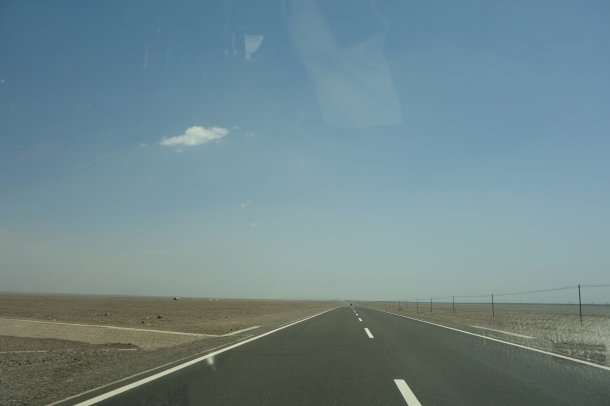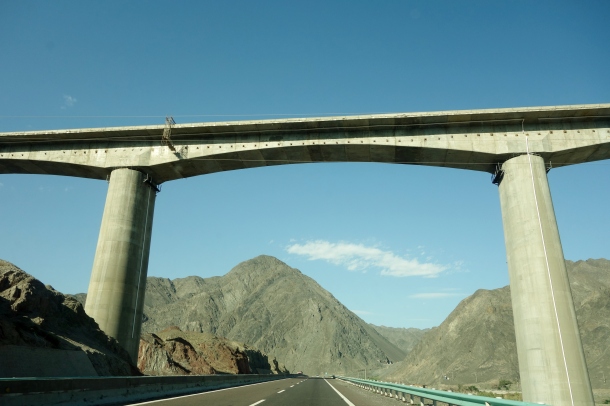In the buildup to the post in which I intend to examine the conflict in Xinjiang, I have been focusing on many of the highlights of the region. In general, I think it helps one better understand events in the present if they are aware of the cultural depth and history of a society. When attempting to understand a conflict, I think this is even more relevant.
However, in my posts, I always try to also convey what an area looks and feels like in general. In other words, I think it is equally important to see what a place is like away from the highlights.
What is it like simply walking down the street? Or driving through the countryside?
The below aren’t award-winning shots as they are often disrupted by the glare from a windshield or your editor’s shaky hands, but I think they help build a broader foundation for understanding the look and feel of Xinjiang.
One theme you’ll soon notice: Emptiness.
In stark contrast to Eastern China, Xinjiang is not heavily populated (yet) and those populations that do exist are primarily in cities such as Urumqi. So, that leaves many stark, open desert landscapes:
If you read Tim Cope’s account (a book I recommend) of making it across the deserts of Kazakhstan as part of his three-year journey to retrace the epic distances covered by the Mongols, it provides one a great appreciation for what it must have been like for early travelers – including the Mongols – to sweep through these landscapes:
There are a few highways out here now, such as the Karakoram Highway or this one that leads toward Tajikistan:
Or this road outside of Kashgar:
However, most of the roads in the area still look like this:
Not that the highways are safer than the typical road of Xinjiang:
And “services” along all of the roadways are pretty basic:
Pictures such as these can be better appreciated if one zooms in on them and picks out the myriad interesting details:
Some of the sights and scenes along the roads of Xinjiang:
My gold standard for being somewhere particularly exotic and interesting is having camels wandering around: Check
The typical mud brick homes of Xinjiang:
The highway from Urumqi to Turpan:
The Chinese government has installed a series of toll barriers along this route that irritate the locals to no end. The driver/fixer we hired for this part of our trip (a Uighur) was normally very cautious about making critical remarks regarding the Chinese government in front of us, but despite his best efforts at restraint, this issue of the tolls would bring out his true feelings.
After discovering that it is not in the nature of The Velvet Rocket staff to serve as informers, our driver/fixer soon switched over to a practice he had cultivated in order to resist the tyranny of the tolls.
He would hide behind large trucks and buses and, as they passed through a toll gate, would hug tightly to their bumpers, simply following them through before the toll gate could be dropped back down again. As soon as we were through, he would whip out from behind the bus or truck and pour on the speed until we were clear of the area. We avoided quite a significant number of toll charges in this way.
This is not a practice entirely without risk though. A friend of his was once gotten caught doing this same trick by a policeman parked right next to the toll gates. As a punishment, the policeman made the friend drive through the toll gates more than 10 times (incurring charges each time):
Aside from the toll barriers, there are two other significant examples of the Chinese presence in Xinjiang that are evident in the landscape on the drive to Turpan.
The first is this massive wind farm (our driver/fixer advised us that it is the largest in China) that one passes through for many miles:
An observation that I found amusing interesting was that all of the older turbines were manufactured by Vestas. You see, the Chinese have simply stolen the technology behind significant aspects of wind turbine production (including from Vestas). Consequently, all of the newer turbines in the wind farm are from Chinese companies. Thus, the wind farm tracks the evolution of Chinese capabilities resulting from industrial espionage:
A rail line constructed to bring turbines and components to the wind farm:
And speaking of railways… The other significant example of the Chinese presence in Xinjiang is this high-speed railway line being constructed to connect Urumqi (the capital of Xinjiang) with Eastern China:
Construction started on the Lanzhou–Urumqi High-Speed Railway (also known as the Lanzhou–Xinjiang Passenger Railway) on November 4, 2009. Upon its completion, an overnight sleeper train is expected to run from Beijing to Urumqi, a distance of 3,450 kilometres (2,140 mi), in less than 12 hours.
That sure beats the hell out of what Amtrak is capable of…
The tracks in the section near Qilianshan Tunnel will run at 3,858 metres (12,657 ft) above sea level, making this the highest high-speed rail track in the world. Trains will run at 350 kilometres per hour (220 mph) on the line.
The total project is estimated to cost 145 billion yuan:
Outside Turpan is another sign of the Chinese presence in the region – and another reason China will hold tightly on to Xinjiang for a while longer: Oil
























